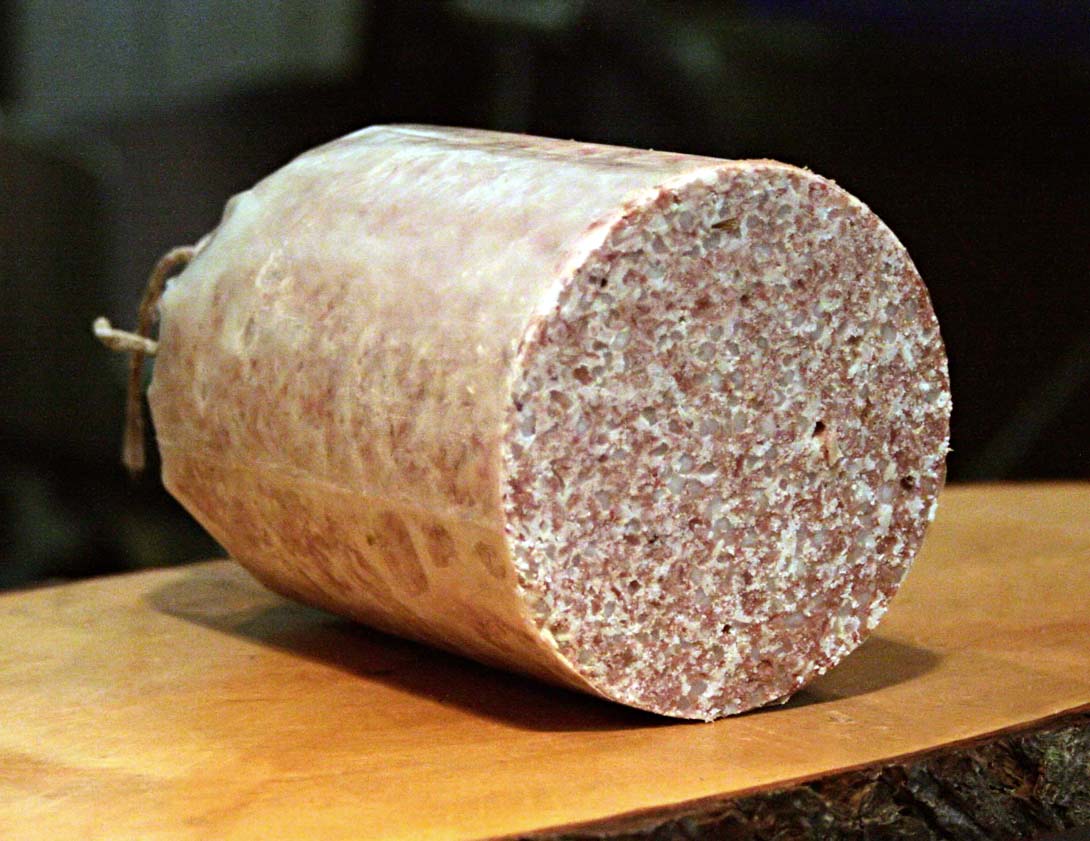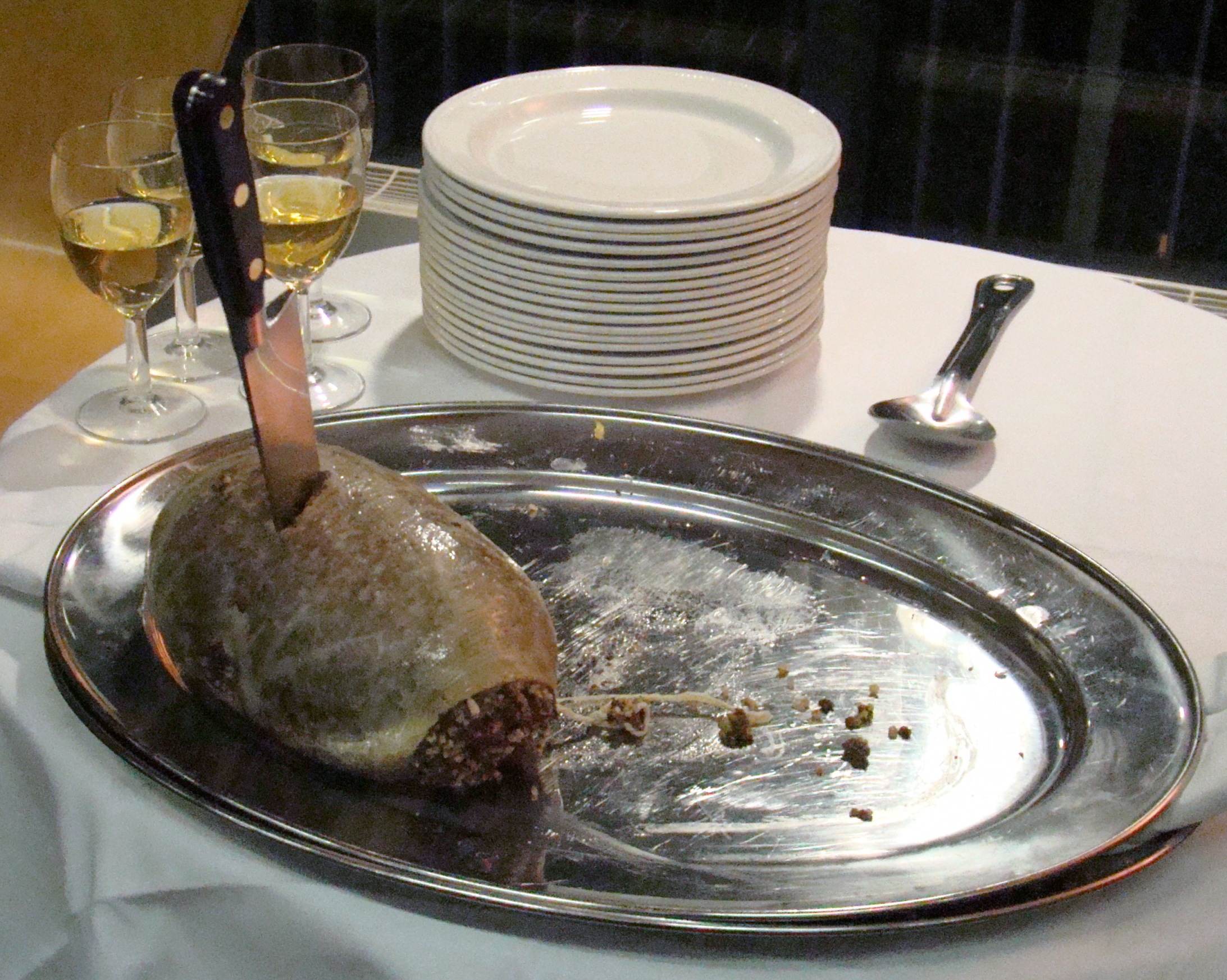|
Stippgrütze
''Stippgrütze'', also called ''Wurstebrei'', is a German dish from Westphalia which is similar to ''Grützwurst'' or ''Knipp''. It consists of barley groats cooked in sausage juices (''Wurstbrühe''), which are enriched with pieces of meat, offal, such as heart, kidney or liver and seasoned with spices and salt. More rarely, finely chopped onions are added. The cooked ingredients are minced after the juices have been poured off and a crumbly cake is left which is held together with fat and which sets on cooling. There are various recipes, but they all contain barley groats, fat and meat. A classic recipe contains pig offal or heart, belly pork with rind, lard greaves, barley groats, water, salt, pepper, allspice and thyme. The nutrition varies; one portion made from about 300 g of pork and 60 g of groats contains about 850 kJ.Dr. Oetker, ''Kochen von A-Z'', p. 502, Dr. Oetker Verlag KG, Bielefeld 2004 Its relatively high fat content means that ''Stippgrütze'' keeps well and i ... [...More Info...] [...Related Items...] OR: [Wikipedia] [Google] [Baidu] |
Pölsa
Pölsa is a traditional northern Swedish dish which has been compared to Hash (food), hash. The main ingredients are beef sinew, liver, heart, lung, onion, and barley, mixed with stock, black pepper, and marjoram. Sometimes ground beef or minced pork is added. It is usually served with mashed or boiled potatoes and pickled beetroot, and sometimes a fried egg. Background The dish plays a central role in the allegorical novel ''Pölsan'' (2002) by Swedish author Torgny Lindgren (1938–2017), in which two men go on a personal quest across postwar Sweden in search of the genuine Swedish "pölsa". The Norwegian and Danish word ''Pølser, pølse'' means sausage and even if the two dishes don't look the same, the two words are related. Pölsa is simply a traditional variety of sausage filling without any casing. See also *Pyttipanna- similar food from Scandinavia * Labskaus- similar food from Northern Germany * lobscouse- similar food from Norway * Scouse (food)- similar food from ... [...More Info...] [...Related Items...] OR: [Wikipedia] [Google] [Baidu] |
Grützwurst
Kaszanka is a traditional blood sausage in the east and central European cuisine. It is made of a mixture of pig's blood, pork offal (commonly liver), and buckwheat or barley (kasza) stuffed in a pig intestine. It is usually flavored with onion, black pepper, and marjoram. The dish probably comes from Germany or Denmark though the latter is unlikely because of a significant difference in ingredients. Danish version consists of blood, pork, raisins, sugar, groats and flour. Kaszanka may be eaten cold, but traditionally it is either grilled or fried with some onions and then served with potato and sauerkraut. Other names and similar dishes * крывянка (''Kryvianka'', Belarus) * ''verivorst'' (Estonia) * ''kaszanka'' (Poland) * '' Kiszka'' (Yiddish קישקע ''kishke'', some districts of Poland) * ''Grützwurst'' (Germany and sometimes Silesia) * ''Tote Oma'' (Germany. A joking-sarcastic name for fried Grützwurst, meaning ''Dead Granny'') * ''Knipp'' (Lower Saxony, Germa ... [...More Info...] [...Related Items...] OR: [Wikipedia] [Google] [Baidu] |
Knipp
''Knipp'' (in the Hanover area: ''Calenberger Pfannenschlag'') is a type of sausage made by mixing meat with grains ('' Grützwurst'') related to '' Pinkel'' which comes from the Bremen Bremen kulinarisch and Lower Saxon cuisine, Lower Saxony regions of . ''Knipp'' is made from oat groats, head, |
Allspice
Allspice, also known as Jamaica pepper, myrtle pepper, pimenta, or pimento, is the dried unripe berry (botany), berry of ''Pimenta dioica'', a Canopy (forest), midcanopy tree native to the Greater Antilles, southern Mexico, and Central America, now cultivated in many warm parts of the world. The name ''allspice'' was coined as early as 1621 by the English, who valued it as a spice that combined the flavours of cinnamon, nutmeg, and clove. Several unrelated fragrant shrubs are called "Carolina allspice" (''Calycanthus floridus''), "Japanese allspice" (''Chimonanthus praecox''), or "wild allspice" (''Lindera benzoin''). Production Allspice is the dried fruit of the ''Pimenta dioica'' plant. The fruits are picked when green and unripe, and are traditionally Drying (food), dried in the sun. When dry, they are brown and resemble large, smooth Black pepper, peppercorns. Fresh leaves are similar in texture to Bay Laurel, bay leaves and similarly used in cooking. Leaves and wood are o ... [...More Info...] [...Related Items...] OR: [Wikipedia] [Google] [Baidu] |
Westphalian Cuisine
Westphalian may refer to: * The culture or people of the Westphalia region of Germany * Westphalian language, one of the major dialect groups of West Low German * Westphalian sovereignty, a concept in international relations * Westphalian (stage), in geology * Westphalian ham (Westfälischer Schinken) produced from acorn-fed pigs raised in Westphalia. The resulting meat is dry cured and then smoked over a mixture of beechwood and juniper branches. Animals * Westphalian horse, a warmblood horse bred in the Westphalia region of western Germany * Westphalian chicken, old hardy landrace of chicken * Westphalian Dachsbracke The Westphalian Dachsbracke is a small, short-legged scenthound, a breed of dog originating in Westphalia, a region of Germany. The Westphalian Dachsbracke was used in Sweden to develop the Drever. Appearance The Westphalian Dachsbracke (''We ..., a small, short legged scenthound {{disambiguation Language and nationality disambiguation pages ... [...More Info...] [...Related Items...] OR: [Wikipedia] [Google] [Baidu] |
Oats
The oat (''Avena sativa''), sometimes called the common oat, is a species of cereal grain grown for its seed, which is known by the same name (usually in the plural, unlike other cereals and pseudocereals). While oats are suitable for human consumption as oatmeal and rolled oats, one of the most common uses is as livestock feed. Oats are a nutrient-rich food associated with lower blood cholesterol when consumed regularly. Avenins are oat gluten proteins, similar to gliadin in wheat. They can trigger celiac disease in a small proportion of people. Also, oat products are frequently contaminated by other gluten-containing grains, mainly wheat and barley. Origin The wild ancestor of ''Avena sativa'' and the closely related minor crop '' A. byzantina'' is '' A. sterilis''. ''A. sterilis'' is a wild oat that is naturally hexaploid. Genetic evidence shows the ancestral forms of ''A. sterilis'' grew in the Fertile Crescent of the Near East. Oats are usually thought to have emerged a ... [...More Info...] [...Related Items...] OR: [Wikipedia] [Google] [Baidu] |
Haggis
Haggis ( gd, taigeis) is a savoury pudding containing sheep's pluck (heart, liver, and lungs), minced with onion, oatmeal, suet, spices, and salt, mixed with stock, and cooked while traditionally encased in the animal's stomach though now an artificial casing is often used instead. According to the 2001 English edition of the ''Larousse Gastronomique'': "Although its description is not immediately appealing, haggis has an excellent nutty texture and delicious savoury flavour". It is believed that food similar to haggis—perishable offal quickly cooked inside an animal's stomach, all conveniently available after a hunt—was eaten from ancient times. Although the name "hagws" or "hagese" was first recorded in England c. 1430, the dish is considered traditionally of Scottish origin. It is even the national dish, as a result of Scots poet Robert Burns' poem "Address to a Haggis" of 1786. Haggis is traditionally served with "neeps and tatties", boiled and mashed separately, and ... [...More Info...] [...Related Items...] OR: [Wikipedia] [Google] [Baidu] |
Potatoes
The potato is a starchy food, a tuber of the plant ''Solanum tuberosum'' and is a root vegetable native to the Americas. The plant is a perennial in the nightshade family Solanaceae. Wild potato species can be found from the southern United States to southern Chile. The potato was originally believed to have been domesticated by Native Americans independently in multiple locations,University of Wisconsin-Madison, ''Finding rewrites the evolutionary history of the origin of potatoes'' (2005/ref> but later genetic studies traced a single origin, in the area of present-day southern Peru and extreme northwestern Bolivia. Potatoes were domesticated there approximately 7,000–10,000 years ago, from a species in the ''Solanum brevicaule'' complex. Lay summary: In the Andes region of South America, where the species is indigenous, some close relatives of the potato are cultivated. Potatoes were introduced to Europe from the Americas by the Spanish in the second half of the 16th c ... [...More Info...] [...Related Items...] OR: [Wikipedia] [Google] [Baidu] |
Rye Bread
Rye bread is a type of bread made with various proportions of flour from rye grain. It can be light or dark in color, depending on the type of flour used and the addition of coloring agents, and is typically denser than bread made from wheat flour. Compared to white bread, it is higher in dietary fiber, fiber, darker in color, and stronger in flavor. Rye bread was considered a staple through the Middle Ages. Many different types of rye grain have come from north-central, western, and eastern European countries such as Iceland, Germany, Austria, Denmark, Sweden, Norway, Finland, Estonia, Latvia, Lithuania, Poland, Belarus, Ukraine, Russia, the Netherlands, Belgium, France, and the Czech Republic and is also a specialty in the canton of Valais in Switzerland. Around 500 AD, the Germanic tribe of Saxon people, Saxons settled in Great Britain, Britain and introduced rye, which was well-suited to its temperate climates. Biochemistry While rye and wheat are genetically similar enou ... [...More Info...] [...Related Items...] OR: [Wikipedia] [Google] [Baidu] |
Dinner
Dinner usually refers to what is in many Western cultures the largest and most formal meal of the day, which is eaten in the evening. Historically, the largest meal used to be eaten around midday, and called dinner. Especially among the elite, it gradually migrated to later in the day over the 16th to 19th centuries. The word has different meanings depending on culture, and may mean a meal of any size eaten at any time of day. In particular, it is still sometimes used for a meal at noon or in the early afternoon on special occasions, such as a Christmas dinner. In hot climates, the main meal is more likely to be eaten in the evening, after the temperature has fallen. Etymology The word is from the Old French () ''disner'', meaning "dine", from the stem of Gallo-Romance ''desjunare'' ("to break one's fast"), from Latin ''dis-'' (which indicates the opposite of an action) + Late Latin ''ieiunare'' ("to fast"), from Latin ''ieiunus'' ("fasting, hungry"). The Romanian word ''deju ... [...More Info...] [...Related Items...] OR: [Wikipedia] [Google] [Baidu] |
Schlachtfest
A ''Schlachtfest'' is the German term for the ritual or ceremonial slaughter of an animal, which is often followed by feast. Today, it usually refers to the practice in many parts of Germany, such as the Palatinate, for a celebration or festival involving the ceremonial slaughter of a pig reared or bought by a private household or an inn for that purpose. The menu for such a ''Schlachtfest'' in the Palatinate includes soup ('' Metzelsuppe''), various sausages ('' Pfälzer Leberwurst, Blutwurst'' and ''Bratwurst''), liver dumplings (''Leberknödel''), boiled belly pork (''Wellfleisch'') and ''Sauerkraut''. It was common when a pig was slaughtered at home that ''Metzelsuppe'' was given as a gift to neighbours, often in milk churns. Frequently the neighbours bought some of the fresh sausages so produced. Wine was drunk with the meal. The slaughter of a pig by an inn was called a ''Schlachtfest''. Within the village everyone knew it was happening because a pig's bladder would be hu ... [...More Info...] [...Related Items...] OR: [Wikipedia] [Google] [Baidu] |







